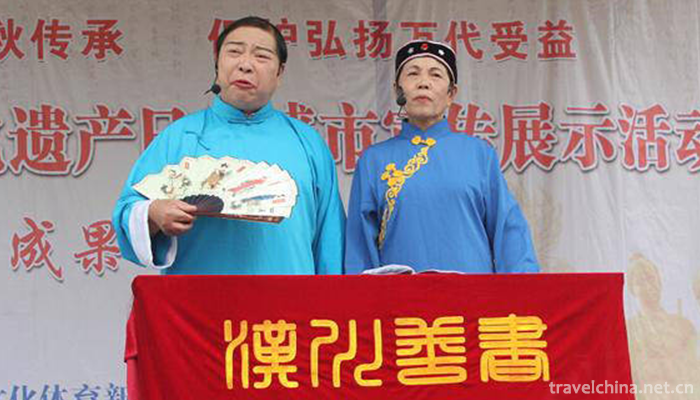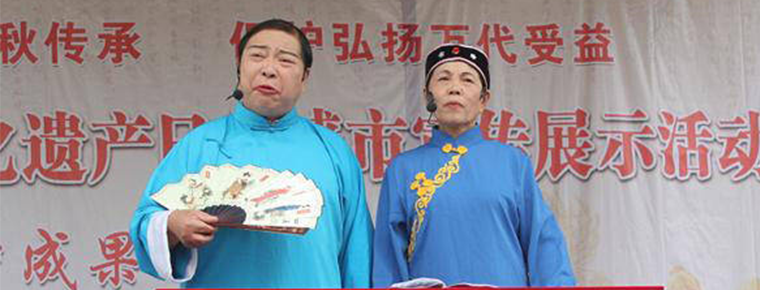Hanchuan good books
Hanchuan good books
Hanchuan Shanshu is a kind of traditional folk music which combines rap and singing in Hubei Province. Since the Qianlong period of the Qing Dynasty, it has a history of 260 years. It has been prevalent in Hubei Province, Kaifeng Henan Province, Leshan Sichuan Province and most of Hunan Province. So far, only the good calligraphers in Hanchuan City of Hubei Province have inherited and developed this kind of music. It is commonly known as preaching good books. Because artists often use "not to speak, tears full face" to start, so folk jokes call it "not to speak".
He Zouhuan, a well-known performance artist and national first-class actor, also believes that the local tone of Hanchuan Shanshu, which integrates the idea of persuading people to be good, has a strong epochal significance and needs to be further inherited and promoted.
On May 20, 2006, the opera was approved by the State Council and listed in the first batch of national intangible cultural heritage list.
Historical evolution
Good books are an important part of traditional folk literature. According to the analysis of the "storytelling figurines" unearthed from the ancient tomb of Tianrizhen, Sichuan Province, they sprouted in the Han Dynasty, and appeared in the Tang Dynasty with the same rhyme, parallel prose and "vulgar speaking" with both rap and singing. Since the Song and Yuan Dynasties, the types of rap and singing literature have been expanding day by day. In Yongle period of Ming Dynasty, there were "Qin Song Goodness Books" printed all over the world. In the Qing Dynasty, good books developed from desk literature to singing literature, and produced good calligraphy and folk art, which was popular in the eight banners of Zhili provinces, then declined in the north and flourished in the south. Besides Wuhan, Xiaogan, Jingzhou and Huanggang in Hubei, there were also artists engaged in such activities in Shanghai, Chongqing, Henan Kaifeng, Sichuan Wanxian, Hunan and Tianjin. After the founding of New China, the good books in the South gradually disappeared. Only the artists in Hanchuan, Caidian and Xiantao of Hubei inherited and developed this kind of music, and gradually formed the "good books in Hanchuan" centered on Hanchuan.
The reason why good books take root, blossom and bear fruit in Hanchuan is that in history Hanchuan was the convergence area of many rivers. From the Qing Dynasty to the Republic of China, nine subsidies were opened on both sides of the Xianghe River and returned to Hanshui. Water towns gradually became plains, and people gradually changed from fishing to farming. Life became more stable, and the demands for culture and education became increasingly urgent. During the Daoguang period, the official propaganda of the oracle was gradually replaced by the folk propaganda of filial piety to parents, harmonious families, friendly neighborhoods, rescue and emergency. At first, it was only preached around the Lantern Festival and the Chinese New Year Festival, and then gradually developed into regular activities. It could be preached in fields, streets and lanes, tea houses and restaurants, and was welcomed by villagers. Around 1936, from the countryside to Wuhan and other towns.
As a narrative style, Shanshu is not required to make up as dramas do, and its form is simple and easy to inherit, so Shanshu was quickly accepted, and developed into a kind of folk music in Hanchuan.
Inheritance status
It is mainly prevalent in Hanchuan, Hanyang and other counties in central Hubei, and in Wuchang and Hankou towns, of which Hanchuan County is the most prevalent. During the Anti-Japanese War, Hanchuan artists introduced it to Chongqing and Wanxian, Sichuan. Good books originated from the "propaganda oracle" in Shunzhi period of Qing Dynasty. The "propaganda of the oracle" is the story of propagating feudal ethics. In Guangxu's reign, "preaching the oracle" was replaced by "Ten Great Goods". It specifically put forward ten good deeds, such as filial piety to parents, harmony in the countryside, setting up righteousness, setting up a righteous ferry, offering tea and sympathizing with lonely and poor people. The map of Hubei advocated honesty and kindness, diligence and frugality, and opposed the evil of rapists and natural harm.
"Hanchuan Shanshu" has more than 300 excellent articles, and more than 100 articles are often preached. More than 300 people specialize in the creation of "Hanchuan Shanshu".
In the new century, influenced by the impact of foreign cultures and the rise of multi-cultures, as well as the death of some accomplished artists, few young people can make their own distinctions, and some excellent songs are on the verge of being lost. Hanchuan Shanshu encounters unprecedented difficulties in the current inheritance and development. Young artists are out of file, and the loss of tradition is serious, which urgently needs support and protection.
The state attaches great importance to the protection of intangible cultural heritage. On May 20, 2006, the opera was approved by the State Council and listed in the first batch of national intangible cultural heritage list.
Inheritance significance
Good book is a kind of folk music that combines rap and singing. Since the Qianlong period of the Qing Dynasty, it has a history of 260 years. It has been prevalent in Hubei, Henan, Sichuan and Hunan. Only the good calligraphers in Hanchuan inherited and developed this kind of music. The aria has a strong Jianghan Plain characteristics, and there are 13 remaining music cards. "Hanchuan Shanshu" has attracted wide attention from scholars at home and abroad.


-
1.dalian forest zoo
Dalian Forest Zoo is located in Baiyun Mountain Scenic Area, Dalian, covering an area of 7.2 square kilometers. The zoo is divided into two parts: the first phase of captivity and the second phase of
Time 2019-01-06 -
2.Qingxiushan Mountain
Qingxiushan Scenic Area is a national AAAAA scenic spot in Nanning. Qingxiu Mountain is a key scenic spot in Nanning. In addition to protecting and restoring the original historic sites
Time 2019-02-07 -
3.Three Mausoleum of Shengjing
The three mausoleums outside Guanzhou refer to the Fuling Tombs of Nuerhachi, the Taizong Emperor of the Qing Dynasty, and the Zhaoling Tombs of the Taizong
Time 2019-02-08 -
4.Spinach with Eight Delicacies
Babao spinach is a traditional Shandong dish, which belongs to Shandong cuisine. It is rich in color, bright, delicious, light and refreshing. In addition to spinach, Babao spinach is also equipped wi
Time 2019-03-25 -
5.Di Shu boxing
Gejiquan is one of the rare traditional types of boxing in southern China, also known as "Gejiu Dog Method", "Dilong Quan" or "Dili Quan". It is commonly known as "D
Time 2019-04-26 -
6.Legend of windbreak
Fangfeng legend is a folk legend in Zhejiang Province. Between Fengshan and Yushan, Sanhe Township of Deqing, Huzhou, Zhejiang Province, the area of Xiazhu Lake is the largest wetland
Time 2019-04-29 -
7.Black Tea Production Techniques
Black tea, originally known as "Border Tea", was smuggled across the border by merchants as early as the end of the 16th century. In the Ming Dynasty, black tea was designated as
Time 2019-05-03 -
8.Huian stone carving
Hui'an stone sculpture mainly served religion in its early stage, with strong religious color. It is mainly embodied in the architectural design, sculpture and installation of the temple,
Time 2019-05-05 -
9.Luo Juan Opera
Luojuan opera, commonly known as trumpet opera, is one of the local operas and one of the national intangible cultural heritages spread in Runan County of Henan Province and Dengzhou City of Henan Pro
Time 2019-05-15 -
10.Xinjiang Opera
Xinjiang Opera, commonly known as "Xinjiang Xiaoqu", is a kind of local opera with unique style, which has been gradually formed and perfected after Shaanxi Opera, Qinghai Pingxian Opera, La
Time 2019-07-06 -
11.Chengdu Technological University
Chengdu Institute of Technology is a public full-time general undergraduate school organized by the People's Government of Sichuan Province. Founded in 1913, the school is the first industrial school
Time 2019-08-31 -
12.Yibin secondary industry
In 2019, the total industrial added value of Yibin City is 99.082 billion yuan, an increase of 9.5% over the previous year, and its contribution rate to economic growth is 45.5%. At the end of the year, there were 824 Industrial Enterprises above Designated Si
Time 2020-12-18